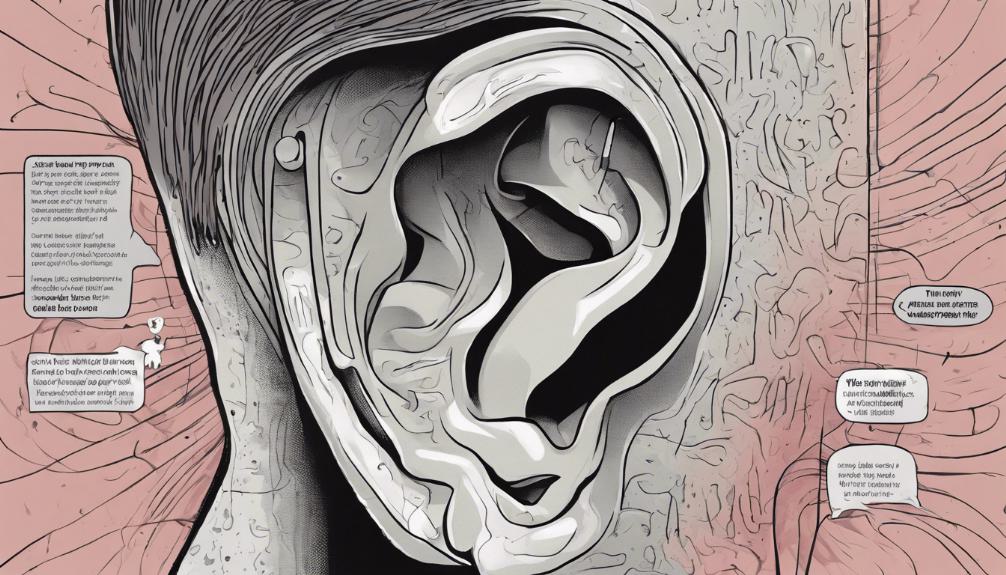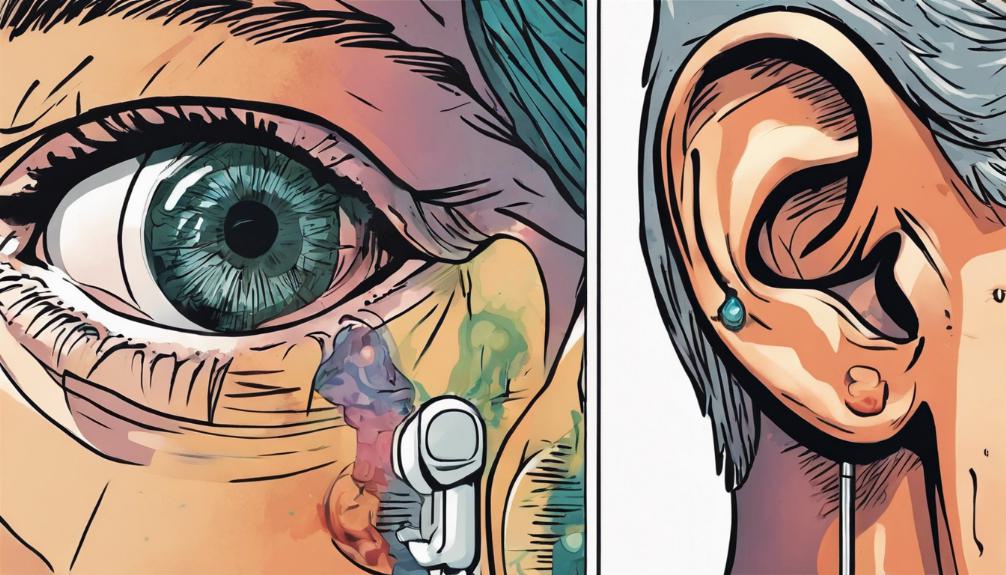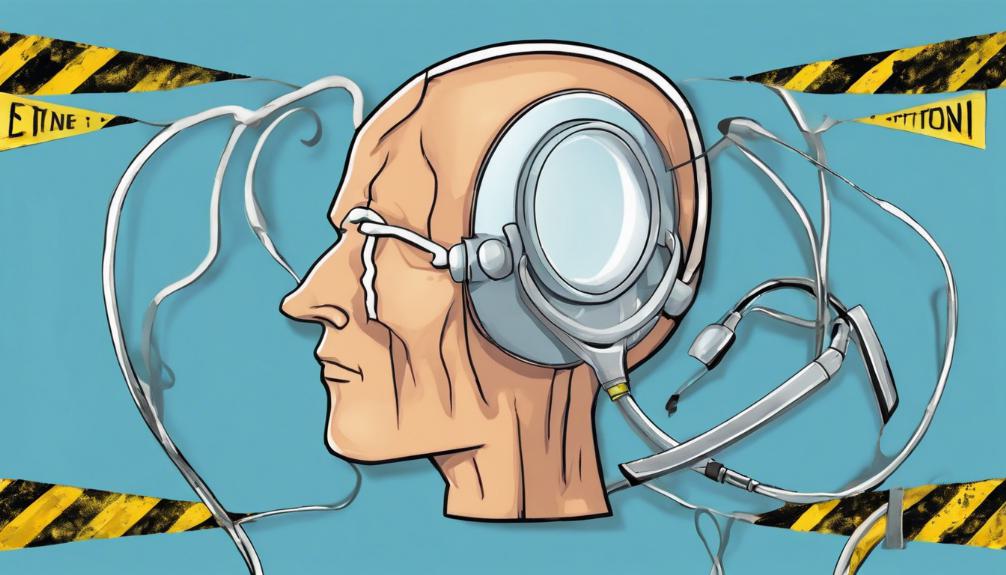Increased Risk of Hearing Impairment With New Thyroid Eye Disease Treatment
The recent revelation that teprotumumab, a groundbreaking treatment for thyroid eye disease, may carry an increased risk of hearing impairment presents a complex challenge for healthcare professionals. As reports surface of patients developing otologic symptoms, such as hearing loss and tinnitus, after treatment, the medical community is prompted to re-evaluate the risk-benefit ratio of this therapy. Despite its proven effectiveness, the emergence of auditory side effects necessitates a closer examination of patient management strategies and the potential need for preemptive auditory assessments. This situation underscores the importance of ongoing vigilance and research in the quest to optimize patient outcomes, inviting further exploration into how these risks can be mitigated whilst harnessing the drug's therapeutic benefits.

Background on Teprotumumab
Teprotumumab, a groundbreaking therapeutic agent, has emerged as a significant advancement in the treatment of thyroid eye disease, offering hope to patients suffering from this debilitating autoimmune condition. Approved by the U.S. Food and Drug Administration (FDA) in January 2020, teprotumumab represents the first drug specifically approved for the management of thyroid eye disease. Characterized by inflammation, swelling, and potentially severe eye bulging, this condition has historically been challenging to treat effectively. The introduction of teprotumumab marks a pivotal shift, providing a targeted therapy that has demonstrated significant improvements in key symptoms such as eye protrusion, double vision, and soft tissue inflammation, thereby enhancing the overall quality of life for affected individuals. Its approval underscores a major breakthrough in the therapeutic landscape for this patient population.
Otologic Symptoms Overview

A significant proportion of patients undergoing treatment with teprotumumab for thyroid eye disease report experiencing various otologic symptoms, including subjective hearing loss and tinnitus. These auditory complaints are not isolated but encompass a range of disturbances such as a sensation of ear plugging and autophony, indicating a broader impact on ear health than previously understood. The emergence of these symptoms, on average, after 3.6 infusions, underscores a notable pattern tied to the treatment regimen. Furthermore, reports of sensorineural hearing loss and patulous eustachian tube disorder among patients highlight the potential severity of these otologic effects. This pattern suggests an intricate link between teprotumumab treatment and auditory system complications, warranting a deeper investigation into the mechanisms at play and the development of management strategies to mitigate these risks.
Study Findings Summary

Building on the observed link between teprotumumab treatment for thyroid eye disease and auditory system complications, recent study findings offer a comprehensive analysis of otologic symptoms experienced by patients. The research highlighted that a significant 65% of patients undergoing teprotumumab therapy reported various otologic symptoms, including subjective hearing loss, tinnitus, a sensation of ear plugging, and autophony. These symptoms typically emerged after an average of 3.6 infusions. Additionally, the study documented cases of sensorineural hearing loss and patulous eustachian tube disorder amongst the affected individuals. This contrasts sharply with prior clinical trials, where only about 10% of patients reported otologic symptoms, underscoring the necessity for further investigation and awareness regarding the auditory risks associated with teprotumumab treatment for thyroid eye disease.
Treatment Efficacy and Risks

While proving to be an effective therapy for thyroid eye disease, teprotumumab has been associated with significant risks, including hearing impairment. Approved by the FDA in January 2020, this treatment has shown considerable improvement in symptoms such as eye protrusion, double vision, soft tissue inflammation, and overall quality of life for patients. However, a study found that 65% of patients treated with teprotumumab reported otologic symptoms, including subjective hearing loss, tinnitus, ear plugging, and autophony, with these symptoms developing after an average of 3.6 infusions. Given these findings, medical practitioners recommend baseline audiogram testing as a precautionary measure. This step aims to screen for potential hearing impairments, highlighting the importance of balancing the benefits of teprotumumab against its auditory risks.
Understanding Thyroid Eye Disease

What is thyroid eye disease, and how does it affect individuals diagnosed with this autoimmune condition? Thyroid eye disease, also known as Graves' orbitopathy, is a condition that primarily affects the eyes and is often associated with an overactive thyroid gland, a hallmark of Graves' disease. This autoimmune disorder leads to inflammation and swelling in the eye muscles and fatty tissues around the eyes, resulting in a host of uncomfortable and potentially debilitating symptoms. Patients may experience dryness, excessive tearing, redness, bulging of the eyes, double vision, difficulty closing their eyes, and in severe cases, vision impairment. The condition not only impacts the physical health of the eyes but can also significantly affect an individual's psychological well-being and quality of life.
Research and Future Directions

Numerous studies are currently underway to further understand the otologic side effects of teprotumumab treatment and explore potential mitigation strategies. Researchers aim to identify the mechanisms driving these auditory disturbances in patients undergoing therapy for thyroid eye disease. By focusing on the biological interactions between teprotumumab and auditory functions, scientists hope to uncover why a subset of patients develops hearing-related symptoms. This research is crucial for developing targeted interventions that could prevent or reduce the incidence of these side effects without compromising the drug's efficacy in treating eye symptoms. Moreover, understanding the timeline and reversibility of otologic symptoms will inform clinical guidelines for monitoring and managing patients on teprotumumab. Collaborative efforts among endocrinologists, otolaryngologists, and audiologists are essential to advance this field of study.
Precautionary Measures

Given the potential otologic side effects associated with teprotumumab treatment, it is crucial to implement precautionary measures to monitor and mitigate these risks effectively. Healthcare professionals should advocate for baseline audiogram testing before initiating therapy, allowing for the early detection of hearing impairment. This baseline serves as a critical reference point for monitoring auditory function throughout the treatment course. Additionally, patients should be informed about the possibility of otologic symptoms, ensuring they report any new or worsening symptoms promptly. Regular follow-up audiograms are recommended to track any changes in hearing, with a focus on identifying sensorineural hearing loss or patulous eustachian tube disorder early. By adopting these strategies, clinicians can take proactive steps to preserve patients' auditory health while treating thyroid eye disease with teprotumumab.
Frequently Asked Questions
Can Hearing Impairment Caused by Teprotumumab Be Reversed if Treatment Is Stopped?**
The question raised pertains to whether hearing impairment, resulting from teprotumumab treatment for thyroid eye disease, can be reversed upon cessation of the therapy. Current research indicates a significant percentage of patients experience otologic symptoms, including hearing loss. However, comprehensive data on the reversibility of these symptoms after discontinuing the treatment is limited. Ongoing studies aim to clarify the potential for recovery, emphasizing the necessity for informed patient counseling and monitoring.
Are There Alternative Treatments for Thyroid Eye Disease That Do Not Carry the Risk of Hearing Impairment?**
For patients seeking alternative treatments for thyroid eye disease that do not carry the risk of hearing impairment, several options are available. These include corticosteroids, which can be administered orally or through IV to reduce inflammation, orbital radiotherapy aimed at decreasing active inflammation, and surgical interventions for decompression, strabismus, or eyelid surgery. Each alternative comes with its own set of potential benefits and risks, and should be considered in consultation with a healthcare provider.
How Does Teprotumumab Treatment Compare With Traditional Therapies in Terms of Cost-Effectiveness and Long-Term Outcomes?**
Teprotumumab treatment for thyroid eye disease, approved by the FDA in 2020, has shown effectiveness in reducing eye protrusion, double vision, and soft tissue inflammation, improving patients' quality of life. Comparatively, traditional therapies may not target the disease mechanism as directly. However, cost-effectiveness and long-term outcomes between teprotumumab and traditional therapies vary, with teprotumumab potentially incurring higher initial costs. Long-term benefits and risks, including hearing impairment, are under continuous evaluation.
Can Lifestyle Changes or Dietary Supplements Reduce the Severity of Thyroid Eye Disease Symptoms or the Need for Teprotumumab Treatment?**
Lifestyle changes and dietary supplements may play a role in managing thyroid eye disease symptoms, potentially reducing the necessity for treatments like teprotumumab. While such non-pharmacological approaches could support overall health and possibly alleviate symptoms, it is crucial to recognize that they may not replace the need for specific medical treatments in all cases. Consulting healthcare professionals for personalized advice is recommended to determine the most effective management strategy for thyroid eye disease.
What Specific Steps Can Patients Already Experiencing Otologic Symptoms Take to Mitigate Further Hearing Damage While Undergoing Teprotumumab Therapy?**
Patients experiencing otologic symptoms during teprotumumab therapy should consult an otolaryngologist for comprehensive evaluation and management. Implementing protective measures, such as avoiding excessive noise exposure and utilizing hearing protection in noisy environments, can reduce potential damage. Regular monitoring through audiometric testing may help in detecting changes in hearing status early. Adhering to these steps, under medical guidance, can mitigate further hearing damage while undergoing treatment for thyroid eye disease.

This post has been generated by AI and was not reviewed by editors. This is Not legal advice. Please consult with an attorney.




